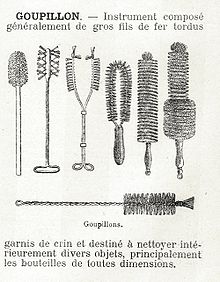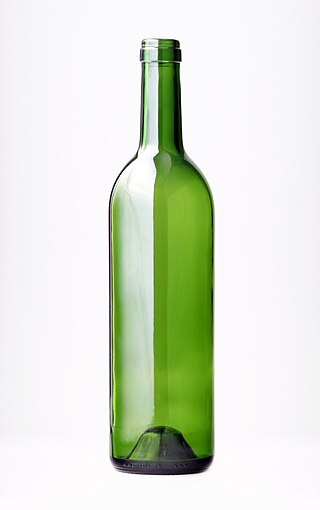
A bottle is a narrow-necked container made of an impermeable material in various shapes and sizes that stores and transports liquids. Its mouth, at the bottling line, can be sealed with an internal stopper, an external bottle cap, a closure, or induction sealing.

Bottled water is drinking water packaged in plastic or glass water bottles. Bottled water may be carbonated or not. Sizes range from small single serving bottles to large carboys for water coolers.

The Oregon Bottle Bill is a container-deposit legislation enacted in the U.S. state of Oregon in 1971 that went into effect in October 1972. It was the first such legislation in the United States. It was amended in 2007 and 2011. It requires applicable beverages in applicable sizes in glass, plastic or metal cans or bottles sold in Oregon to be returnable with a minimum refund value. The refund value was initially 5 cents until April 1, 2017, when it increased to 10 cents. The Oregon Legislature has given the Oregon Liquor Control Commission the authority to administer and enforce the Bottle Bill. Oregon Beverage Recycling Cooperative (OBRC), a private cooperative owned by retailers and beverage distributors, administers the collection and transportation of returned containers and keeps all the unclaimed deposits. Materials from returned containers are sold by the OBRC and proceeds are handed out to beverage distributors. In 2022, the bottle bill was expanded to include canned wine, which will become eligible for redemption on July 1, 2025.

Container-deposit legislation is any law that requires the collection of a monetary deposit on beverage containers at the point of sale and/or the payment of refund value to the consumers. When the container is returned to an authorized redemption center, or retailer in some jurisdictions, the deposit is partly or fully refunded to the redeemer. It is a deposit-refund system.

A water bottle is a container that is used to hold liquids, mainly water, for the purpose of transporting a drink while travelling or while otherwise away from a supply of potable water.

Glass milk bottles are glass bottles used for milk. They are reusable and returnable - used mainly for doorstep delivery of fresh milk by milkmen. Once customers have finished the milk, empty bottles are expected to be rinsed and left on the doorstep for collection, or rinsed bottles may be returned to a participating retail store. Bottle sizes vary depending on region, but common sizes include pint, quart or litre.

Glass recycling is the processing of waste glass into usable products. Glass that is crushed or imploded and ready to be remelted is called cullet. There are two types of cullet: internal and external. Internal cullet is composed of defective products detected and rejected by a quality control process during the industrial process of glass manufacturing, transition phases of product changes and production offcuts. External cullet is waste glass that has been collected or reprocessed with the purpose of recycling. External cullet is classified as waste. The word "cullet", when used in the context of end-of-waste, will always refer to external cullet.
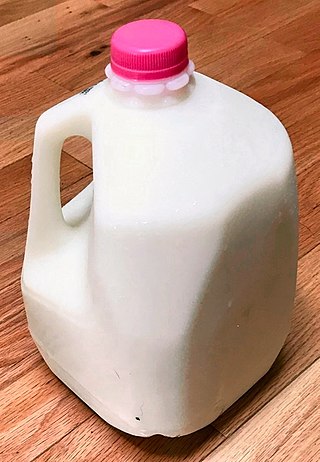
Plastic milk containers are plastic containers for storing, shipping and dispensing milk. Plastic bottles, sometimes called jugs, have largely replaced glass bottles for home consumption. Glass milk bottles have traditionally been reusable while light-weight plastic bottles are designed for single trips and plastic recycling.

Reuse is the action or practice of using an item, whether for its original purpose or to fulfill a different function. It should be distinguished from recycling, which is the breaking down of used items to make raw materials for the manufacture of new products. Reuse – by taking, but not reprocessing, previously used items – helps save time, money, energy and resources. In broader economic terms, it can make quality products available to people and organizations with limited means, while generating jobs and business activity that contribute to the economy.
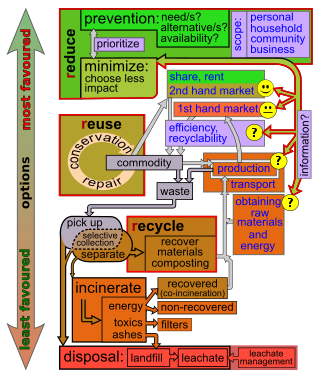
Waste minimisation is a set of processes and practices intended to reduce the amount of waste produced. By reducing or eliminating the generation of harmful and persistent wastes, waste minimisation supports efforts to promote a more sustainable society. Waste minimisation involves redesigning products and processes and/or changing societal patterns of consumption and production.
California Redemption Value (CRV), also known as California Refund Value, is a regulatory fee paid on recyclable beverage containers in the U.S. state of California. The fee was established by the California Beverage Container Recycling and Litter Reduction Act of 1986 and further extended to additional beverage types in California State Senate Bill No. 1013, signed into law on September 28, 2022 and taking effect on January 1, 2024; since 2010 the program has been administered by the Cal/EPA California Department of Resources Recycling and Recovery (CalRecycle).

A plastic bottle is a bottle constructed from high-density or low density plastic. Plastic bottles are typically used to store liquids such as water, soft drinks, motor oil, cooking oil, medicine, shampoo, milk, and ink. The size ranges from very small bottles to large carboys. Consumer blow molded containers often have integral handles or are shaped to facilitate grasping.
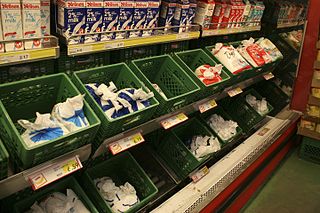
A milk bag is a plastic bag that contains milk. Usually one of the corners is cut off to allow for pouring, and the bag is stored in a pitcher or jug.

Disposable food packaging comprises disposable products often found in fast-food restaurants, take-out restaurants and catering establishments. Typical products are foam food containers, plates, bowls, cups, utensils, doilies and tray papers. These products can be made from a number of materials including plastics, paper, bioresins, wood and bamboo.

There are ten states in the United States of America with container deposit legislation, popularly called "bottle bills" after the Oregon Bottle Bill, the first such legislation that was passed.
Bottles are able to be recycled and this is generally a positive option. Bottles are collected via kerbside collection or returned using a bottle deposit system. Currently just over half of plastic bottles are recycled globally. About 1 million plastic bottles are bought around the world every minute and only about 50% are recycled.
The Massachusetts Bottle Bill is a container-deposit legislation dealing with recycling in the United States that originally passed in the U.S. state of Massachusetts in 1982 as the Beverage Container Recovery Law. Implemented in 1983, the law requires containers of carbonated beverages to be returnable with a minimum return value of $0.05. The bottle bill does not cover containers of non-carbonated beverages like water, tea, or sports drinks. The law also establishes the handling fee paid by distributors to redemption centers, $0.0325 per unit as of July 5, 2013, and to retailers $0.0225 per unit. As the number of non-deposit beverage containers has increased to represent over one-third of beverage containers sold, the Bottle Bill has no influence on these non-deposit containers, with the result that these containers are three times more likely to be found as litter in Massachusetts communities. Additional studies indicate that beverage containers covered by the state's container deposit system are redeemed at approximately 70% and another 9% are recycled via curbside programs. Conversely, containers that are not covered, such as bottled water, juices, and sports drinks, are recycled at approximately 25%.
Reusable packaging is manufactured of durable materials and is specifically designed for multiple trips and extended life. A reusable package or container is "designed for reuse without impairment of its protective function." The term returnable is sometimes used interchangeably but it can also include returning packages or components for other than reuse: recycling, disposal, incineration, etc. Typically, the materials used to make returnable packaging include steel, wood, polypropylene sheets or other plastic materials.

The history of bottle recycling in the United States has been characterized by four distinct stages. In the first stage, during the late 18th century and early 19th century, most bottles were reused or returned. When bottles were mass-produced, people started throwing them out, which led to the introduction of bottle deposits. However, during the second stage, after World War II, consumption patterns changed and nonreturnable containers became popular, which littered the environment. Some states implemented "bottle bills" that instituted deposits. The beverage-container industry first implemented private recycling programs and then pushed for municipal curbside recycling as an alternative to "bottle bills". More recently, PET bottles have largely replaced other materials. The United States used to be the front-runner when it came to recycling PET, but European countries have since outpaced the US.

Packaging waste, the part of the waste that consists of packaging and packaging material, is a major part of the total global waste, and the major part of the packaging waste consists of single-use plastic food packaging, a hallmark of throwaway culture. Notable examples for which the need for regulation was recognized early, are "containers of liquids for human consumption", i.e. plastic bottles and the like. In Europe, the Germans top the list of packaging waste producers with more than 220 kilos of packaging per capita.

